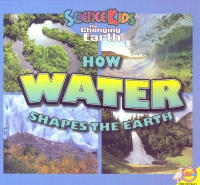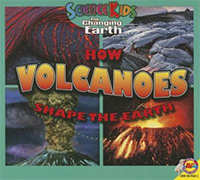| ________________
CM . . . . Volume XXI Number 23 . . . . February 20, 2015
excerpts:
These titles are part of the "Science Kids: The Changing World" series from Weigl's Let's Read AV² Media Enhanced collection designed for children aged 5 to 7. Focusing on Earth Science, each book describes the forces that affect the Earth and its landforms. Factual text is set within a large textbox accompanied by colourful photographs which cover two thirds of the double page spread. The books in the series are designed in a standard format. The headings, written as questions in each table of contents, vary slightly according to the topic. For example, there are more headings starting with "How" in How Water Shapes the Earth and more that begin with "What" in How Volcanoes Shape the Earth, indicating how information is conveyed differently within each book. At the end of each book, there is a section entitled "Water Facts" or "Volcano Facts". These pages provide supplementary information and are intended for use by adults to assist young readers in understanding these natural forces. First appearance sight words and content words are listed on the Key Words page at the end of the book. These words can be taught and reviewed before and during the reading process. With Weigl's AV² Media Enhanced Books, logging onto the www.av2books.com website with the security code allows the young child to use the audio book features. This enables the Early Years reader to listen to the recorded text on each stage of the life cycle, reinforcing the vocabulary development of the Key Words. In "The Changing Earth" series, however, the reading level is listed in the catalogue as grade 2. The concepts behind these Earth shaping forces are more likely to be unfamiliar to young readers, thereby making these titles more appropriate for grades 2 and higher. In How Water Shapes the Earth, although the extra facts provided for adults at the end of each book will assist in further explanation, the young reader will have difficulty with unfamiliar terms, such as glaciers, topsoil and tsunamis, as well concepts such as dams using "the energy of water to help power homes." The large attractive photographs do not convey the cause and effect that is found in the written text. In the section "What is the Water Cycle?", a diagram is provided, but it is not labeled, and the arrows do not convey a cyclical direction for a young reader. Other media features are also provided. Supplementary videos and websites can be accessed by the child. The videos for How Volcanoes Shape the Earth are effective, but the websites are either too difficult or contain few supportive facts. Projecting these websites and some of the video components onto a white board might be useful for teaching and class discussions. However, for How Water Shapes the Earth, the content of the video on the flow of water contains information that is above the targeted age level. Similarly the National Geographic webpage video on waves discusses how energy is formed in a wave but does not relate this to erosion which is the focus of the text, although this term is not used. Activities, such as word searches, word scrambles, and matching activities, are also provided. Reading information text is an important literacy skill to introduce to Early Years children. The bold, simple text and quality photographs make these books attractive to the early reader, but, with the more complex concepts in this series, a single large photograph might not provide the visual cues to assist the child in understanding the text. Apart from the audio read along feature, however, the other media components seem to be designed more for teacher use than for the child, and some of the content is not age appropriate. Recommended with Reservations. Janice Foster is a retired teacher and teacher-librarian in Winnipeg, MB. Copyright © the Manitoba Library Association. Reproduction for personal use is permitted only if this copyright notice is maintained. Any other reproduction is prohibited without permission.
Next Review |
Table of Contents for This Issue
- February 20, 2015. |

